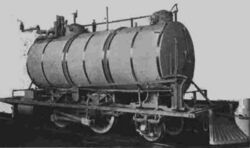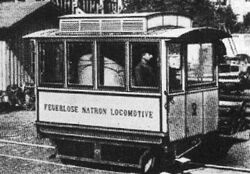Engineering:Soda locomotive
Soda locomotives were a variant of fireless locomotives, in which steam was raised in a boiler, expanded through cylinders in the usual way, and then condensed in a tank of caustic soda that surrounded the boiler. Dissolving water in caustic soda liberated heat, which generated more steam from the boiler, until the caustic soda became too dilute to release heat at a useful temperature.
Technical description
These closed-loop steam engines had no firebox. The boiler was jacketed by a container loaded with about 5 tons of caustic soda (sodium hydroxide). When water or steam came in contact with the caustic soda, it would generate heat—enough to actually run the boiler and generate more steam. Steam emanating from the boiler would be fed through pistons to propel the locomotive forward, and the exhaust steam from the pistons would be fed into the caustic soda to continue the cycle. These vehicles were virtually silent, because the steam was not released into the atmosphere.
A soda locomotive could run for several hours, but eventually the soda would become diluted and wouldn't produce enough heat to continue generating steam. For reconcentrating, the caustic soda was either transferred out of the boiler of the locomotive and boiled in open vats, or, rather more conveniently, by injecting superheated steam at a high enough temperature to boil off the water in solution. A stationary boiler would be hooked up and feed superheated steam through the soda to boil off the water and effectively recharge the soda.[1]
These locomotives were always called "soda locomotives" (sodium carbonate) although "caustic soda locomotives" (sodium hydroxide) would be a more precise description. The misleading terminology was most likely used, to increase their acceptance by the public, which was used to using washing soda but might have been frightened by the nasty alkali burns sitting next to several tons of hot caustic soda.[2]
Other salts such as calcium chloride could also be used.
Advantages and disadvantages
Advantages
- The soda locomotives were quiet, by which they were more beneficial than compressed-air motors.
- The soda locomotives did not leave any smoke, sparks or soot.
- Low quality coal could be used in the fixed installation that reconcentrated the caustic soda.
- There was no need to carry coal around.[2]
Disadvantages
- The weight of the big tank of caustic soda reduced performance or efficiency.
- The risk of nasty burns caused by caustic soda. A boiler explosion would have had very serious consequences.[2]
- The reconcentration boilers needed to be replaced regularly due to corrosion.
Locomotives
- The Perkins calcium chloride engine, 1864[3]
- The Spence caustic soda boiler, 1874[4][5]
- The Honigmann caustic soda locomotive, 1885[6][7]
- The Baldwin soda motors, 1886
References
- ↑ Hicks, Michael (May 18, 2012). "Soda motor exterior". https://www.flickr.com/photos/mulad/7222500234/in/photostream/.
- ↑ 2.0 2.1 2.2 "The Caustic Soda Locomotives". July 17, 2005. http://www.douglas-self.com/MUSEUM/LOCOLOCO/soda/soda.htm.
- ↑ "Utilisation of Waste Steam". The Engineer. 20 February 1874. https://books.google.com/books?id=EFFHAQAAMAAJ&pg=PA130. (p. 130, middle of the right column)
- ↑ Engineering. April 1885.[full citation needed]
- ↑ "Steam Regeneration". The Engineer. 20 February 1874. https://books.google.com/books?id=EFFHAQAAMAAJ&pg=PA300. (p. 300, middle column)
- ↑ British Journal for Engineering. 27 February 1885.[full citation needed]
- ↑ Lawrence Saunders, Notes on the Newcastle Exhibition, The Railway Engineer, Vol. VIII, No. 6 (June 1887); pages 180-183 (see 182, bottom of left column).
 |




